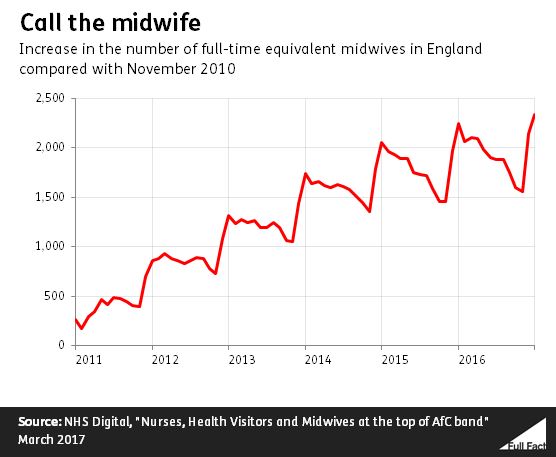“You talk about the Pay Review Body, the Pay Review Body reports that 80% of the women, of the midwives, that left the profession would’ve stayed if they were valued more highly.”
BBC Question Time audience member, 29 June 2017
80% of midwives intending to leave midwifery in the next two years said that increased pay would encourage them to stay in midwifery. That’s according to evidence from the Royal College of Midwives (RCM) published by the NHS Pay Review Body in 2017.
The RCM also said that the most common reasons given for leaving the profession overall were staffing and workload.
We should consider how this information was gathered. The RCM conducted a survey in August 2016 to determine why midwives leave the profession. They said, “The survey was sent by email to RCM members and promoted on the RCM social media streams. We asked midwives to complete the survey if they had left midwifery in the last two years or are intending to leave in the next two years. There were 2,719 responses in total.”
31% of those responses were from midwives who had already left, while 69% planned to leave in the next two years. 85% of respondents were based in England, 9% in Scotland, around 3% in Wales and about 3% in Northern Ireland.
It’s important to look at this comment in the context of the survey as a whole. While 80% of those considering leaving said higher pay was something that might make them stay 95% mentioned higher staffing levels, 92% said a change in workload would make them consider staying and 86% mentioned a change in workload would make them think again.
And only 9% of those who had actually left said they left because they were not happy with their pay. When asked what might encourage them to return appropriate staffing levels (88%), a change in workload (83%) , more support from management (81%) and a change in working conditions (81%) were all considered more important than increased pay.
Leaving rates for midwives in England have increased from 7.4% in 2010/11 to 10% in 2015/16. However joining rates for the profession over the same time period also increased, from 9.2% in 2010/11 to 10.6% in 2015/16. Overall, there were the equivalent of about 2,000 more midwives in November 2016 than there were in November 2010. The number of midwives has been generally increasing over this time, but it does vary widely from month to month.

The NHS pay cap of 1% has resulted in the value of a band six midwife’s pay falling by £6,000 from 2010 to 2016 compared to the level it would have been at if it had kept pace with inflation, according to the RCM.It also reports that this is set to increase to a gap of £9,000 by 2020 if the pay cap continues.
Overall the NHS Pay Review Body concluded: “we are concerned that, in too many places, the default strategy to deal with significant increases in patient demand within a slowly increasing budget is by expecting NHS staff to work more intensively, in more stressful working environments, for pay that continues to decrease in real terms. We do not consider this a sustainable position.”
